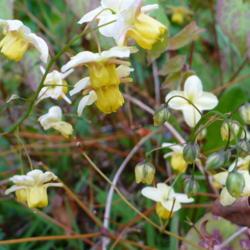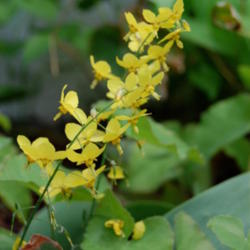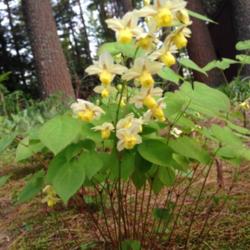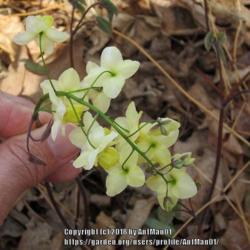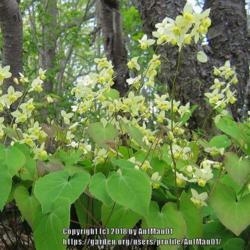zuzu said:
1)
I'll start by addressing the simplest matter. You say that the CoL does not recognize E. omeiense. It does recognize it as an accepted hybrid taxon and we have had an entry for Epimedium x omeiense since the first day of our database (9/16/2011). http://www.catalogueoflife.org...
Epimedium x omeiense
2)
It also recognizes E. sasakii as a hybrid taxon. Our own entry did not have the required "x," so I have edited it to add the "x." http://www.catalogueoflife.org...
Epimedium x sasakii
3)
Now, on to the more complicated matters. We use the Catalogue of Life because it is the most comprehensive and most current (updated just yesterday, actually, and listing November 2017 as the latest taxonomic scrutiny of the epimedium entries) taxonomic source available to us.
4)
It still does not list E. versicolor as an accepted hybrid taxon. It could do this in the future, especially now that Kew has become one of its main sources. I'm going to edit our cultivar entries for Sulphureum and Neosulphureum to remove the species name, but I will list it in the also-sold-as field. That way, it wil be easy to find the E. x versicolor cultivars when and if the CoL lists it as an accepted hybrid taxon.
5)
I need your help with something else. We have two other cultivars listing E. versicolor as a synonym: Discolor and Cupreum. Fairy Wings (Epimedium 'Cupreum') Should I edit these in the same way?
6)
I'll also move HemNorth's two photos to the 'Sulphureum' entry. Is Calif_Sue's 'Neosulphureum' photo in the right place? Bishops Hat (Epimedium 'Neosulphureum')
Hi Zuzu, thanks again for your comprehensive response. To help track my response, I added numbers to the 6 main points.
1. Catalog of Life (CoL) and Epimedium x omeiense. You're correct, I was searching in CoL with a misspelling (was spelling it from memory, left out one a middle "e", sorry about that.
I see under "additional information" it lists: Hybrid taxon. Epimedium acuminatum x fangii (excellent)
2. CoL entry for Epimedium sasakii, I missed seeing the "additional information" field that lists: Hybrid taxon.
3. CoL. I'm exploring it, seems to be more definitive than TPL (The Plant List), a consortium of resources including Kew, unfortunately they leave many taxa as "Unresolved" or "Unassessed" which is frustrating. For genus Epimedium, much of the taxonomy came from later 1800s and early 1900s, and at the time botanical nomenclature allowed publishing names for hybrid groups, both for natural hybrids and man-made interspecific hybrids. In essence many such names have been "grandfathered" into modern taxonomy. Besides omeiense & sasaki, (both are natural hybrid groups) I checked other Epimedium names for hybrid groups ("nat" = natural hybrids "mm" = man-made hybrids)
x cantabrigiense (mm) - CoL: Hybrid taxon. Epimedium alpinum x pubigerum
x perralchicum (mm) - CoL: not found
x rubrum (mm) - CoL: not found
x setosum (nat) - CoL: listed as accepted species (it's not a species), no indication of hybrid taxon.
x versicolor (mm) - CoL: listed as synonym of grandiflorum (however for the published name E. versicolor)
x warleyense (mm) - CoL: not found
x youngianum (nat) - CoL: Hybrid taxon. Epimedium diphyllum x grandiflorum
The Plant List lists most of these as unresolved. CoL seems to recognize names for natural hybrids and not man-made hybrid groups (even though those names were formally published), but there's the exception where CoL does accept "x cantabrigiense", hybrids made in Cambridge, England in the early 1930s.
4. Zuzu, your suggestion to remove the "species" name is a more acceptable method of indicating the cultivar, rather than ascribing it to only one of the two parent species names. Since "x versicolor" represents two very different species (grandiflorum & pinnatum ssp. colchicum), and the hybrid group was published and been in use since the mid 1800s, it would be misleading to refer to 'Sulphureum' as either Epimedium grandiflorum 'Sulphureum' or Epimedium pinnatum ssp. colchicum 'Sulphureum', which parent would one favor, doesn't make sense... so better to omit species name.
5. 'Discolor' & 'Cupreum'.
'Discolor' is listed in TPL as a synonym for Epimedium x versicolor. Stearn lists it specifically as a synonym of Epimedium x versicolor 'Versicolor'. Oh my, that's confusing, buy Yes, among the hybrid group name "x versicolor" from the mid 1800s, there were four cultivar named in the same period: 'Cupreum', 'Neosulphurem', 'Sulphureum' and 'Versicolor'. CoL listed 'Discolor' as a synonym of E. grandiflorum.
The name 'Discolor' seems firmly in synonym, never have encountered a plant by that name, thus my surprise hearing this question. Googling around, I found the unfortunate mistake in a recently published book "The Plant Lovers Guide to Epimediums", where the century-and-a-half old invalid name has been brought back from the dead and given spotlight treatment to it, the book author saying about Discolor that it was originally called 'Versicolor'. No! This book is not a taxonomic work, so I consider that an unfortunate mistake.
https://books.google.com/books...
Long and short of it. 'Discolor' is an invalid name (variously assigned) and 'Cupreum' is a valid name for E. x versicolor.
6. Calif_Sue's photo labeled as Epimedium 'Neosulphureum', I cannot see the floral parts, too far away and a bit fuzzy, to make a determination. The cups look very bright yellow which also signals to me it might not be Neosulphureum, but that could just be the lighting or photography. Now that you have a Epimedium 'Neosulphureum' record, I can post some close-up diagnostic photos I have.
